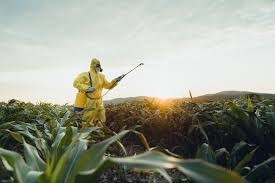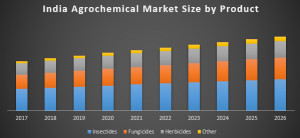
After the United States, Japan, and China, India is the world's fourth-largest manufacturer of agrochemicals. For the Indian economy, the agrochemical industry is very important. From USD 1.22 billion in FY08 to an approximate USD 1.36 billion in FY09, the Indian agrochemicals industry rose at a rate of 11%. India's agrochemical intake is among the lowest in the world, at 0.58 kilograms per hectare, comparable to 4.5 kilograms per hectare in the United States and 11 kilograms per hectare in Japan. Paddy accounts for the bulk of pesticide use in India (around 28 percent), preceded by cotton (20 %).
Related Projects:- Disinfectants, Pesticides, Insecticides, Mosquito Repellents, Destroyers, Phenyl, Fertilizer, Fungicides, Herbicides, Plant Regulator, Plant Growth Regulator, Mixture, Intermediates, Agrochemicals, Bio Stimulate, Growth Activator, Organic Pesticides
Key Segments

· Insecticides are compounds that are used to repel or destroy insects. Since the advent of BT cotton, insecticide use for cotton fell to 50% from 63 % of total production.
· Fungicides are used to protect crops from disease. Fungicide use has risen in India as a result of the government’s funding for the horticulture industry. Fungicides’ market share rose from 16 percent in 2004 to 20 percent in 2009.
· Herbicides are the extremely fast agrochemical category. Their biggest competitor is low-cost labor, which is used to manually pick weeds. Weeds prosper in damp, mild weather and perish during cold periods, so revenues are seasonal.
· Pesticides derived from natural sources such as animals, plants, bacteria, and minerals are known as bio-pesticides. The biopesticides industry, which is currently a small sector, is projected to expand in the future as a result of government funding and expanded concern about the use of non-toxic, environmentally friendly pesticides.
Read our Books Here: The Complete Technology Book on Pesticides, Insecticides, Fungicides and Herbicides (Agrochemicals) with Formulae, Manufacturing Process, Machinery & Equipment Details 2nd Revised Edition
· Plant growth inhibitors, nematocides, rodenticides, fumigants, and other pesticides are examples.
Related Videos: - Chemicals (Organic, Inorganic, Industrial)
Market Trends

The government and industry will work together to produce environmentally sustainable pesticides. With financial support from the United Nations Development Programme, the Department of Chemicals has launched a national program titled "Development and processing of neem products as environmentally friendly pesticides".
Larger organizations should place more emphasis on brand building by hosting farmer awareness camps and delivering full solutions.
Increased corporate partnerships between major firms for broader market penetration, as well as multinational acquisitions of smaller companies to diversify product portfolio. Besides, UPL has made several minor purchases around the world to expand into new markets and acquire product experience.
Key Opportunities
Ø Increased consumption potential- With 35-40% of total farmland under crop protection, there is a large untapped demand to tap into. Indian companies would expect to improve pesticide use by educating farmers and implementing specialized training on the value of using agrochemicals.
Ø Massive export opportunities- Taking advantage of India's low-cost producer status, the surplus production capacity is an excellent opportunity to raise exports.
Ø Product portfolio expansion- Threats like genetically modified seeds, Integrated Pest Management, organic farming, etc. can be turned into opportunities if the industry re-orients itself to better address the needs of its consumers and broadens its product offering to include a range of agri-inputs instead of only agrochemicals.
Related Books: - Agrochemicals, Pesticides, Insecticides, Fungicides, Herbicides, Biofertilizer, Vermicompost Manufacturing
Competitive Landscape
With over 800 formulators, the Indian agrochemicals industry is extremely concentrated. With a huge number of coordinated sector players and a considerable share of bogus pesticides, the rivalry is fierce. Big players have been buying out small producers in the industry, resulting in mergers and acquisitions.
United Phosphorus Ltd, Bayer CropScience Ltd, Rallis India Ltd, Gharda Chemicals Ltd, Syngenta India Ltd, BASF India Ltd, among others are the main industry players. Nearly 80% of the industry is dominated by the top ten firms. Large players' market share is largely determined by their product portfolio and the launch of new molecules.
Recent Government Initiatives to Boost Agro-Chemical Sector
The Transport and Marketing Assistance (TMA) scheme was created by the Indian government to provide financial assistance for agricultural product transportation and marketing to improve agricultural exports.
The Government of India approved the Agriculture Export Scheme, 2018 in December 2018. With a flexible trade policy framework, the new policy targeted to increase India's agricultural exports to US$ 60 billion by 2022 and US$ 100 billion over the coming few years.
The Indian government will spend Rs. 2,000 crore (US$ 306.29 million) in the computerization of the Primary Agricultural Credit Society (PACS) to ensure that cooperatives benefit from modern technologies.
Related Videos: - Books on Agrochemicals, Pesticides, Insecticides, Fungicides, Herbicides
NIIR PROJECT CONSULTANCY SERVICES (NPCS) is a reliable name within the industrial world for providing integrated technical practice services. NPCS is manned by engineers, planners, specialists, money consultants, economic analysts, and style specialists with in-depth expertise within the connected industries.
This report is led by NPCs, which is a reliable and assuring site to trust. We provide the latest reports with the closest accuracy to provide the best information to our readers.
PM_Art2021
#DetailedProjectReport #businessconsultant #BusinessPlan #feasibilityReport #NPCS #industrialproject #entrepreneurindia #startupbusiness #BusinessIdeas #StartupBusinessIdeas #BusinessOpportunity #AgroChemicalIndustry #AgroChemicalMarket #AgroChemical #Chemical #ChemicalIndustry